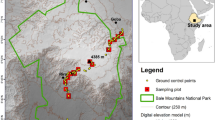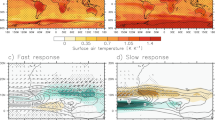Abstract
Western and Van Praet1 have convincingly suggested that losses of yellow fever-trees in the Maasi Ambolesi are not due to over-population by cattle or elephants but to a climatic change causing a shift in the salt table. They assume that the change is part of a cycle, though of a much smaller range than has occurred in the past 10,000 yr. Perhaps inadvertently, they seem to suggest that the cycle producing the present vegetation change lasts about a century. Much shorter cycles than this may, however, be usual in the region, as evidence from further south suggests. It is important that this should be appreciated because, as the authors state, investment by governments on developments to accommodate tourists may be wasted if the climate is wrongly forecast.
This is a preview of subscription content, access via your institution
Access options
Subscribe to this journal
Receive 51 print issues and online access
$199.00 per year
only $3.90 per issue
Buy this article
- Purchase on SpringerLink
- Instant access to full article PDF
Prices may be subject to local taxes which are calculated during checkout
Similar content being viewed by others
References
Western, D., and Van Praet, C., Nature, 241, 104 (1973).
Butzer, K. W., Isaac, G. L., Richardson, J. L., and Wasbourn-Kamau, C., Science, 175, 1069 (1972).
Gunn, D. L., Tanganyika Notes and Records, 42, 1 (1956).
Symmons, P. M., Bull. Ent. Res., 50, 507 (1959).
Annual Reports of the International Red Locust Control Service, Abercorn, Northern Rhodesia (Mbala, Zambia).
Gunn, D. L., and Symmons, P. M., Nature, 184, 1425 (1959).
Author information
Authors and Affiliations
Rights and permissions
About this article
Cite this article
GUNN, D. Consequences of Cycles in East African Climate. Nature 242, 457 (1973). https://doi.org/10.1038/242457a0
Received:
Published:
Issue date:
DOI: https://doi.org/10.1038/242457a0
This article is cited by
-
Diversity and fine-scale spatial genetic structure of Cyperus papyrus populations in Lake Naivasha (Kenya) using microsatellite markers
Hydrobiologia (2014)
-
The sponge Dosilia brouni (Spongillidae) in Lake Baringo, Gregory Rift, Kenya
Hydrobiologia (1991)
-
Vegetation changes in a shallow African Lake: Response of the vegetation to a recent dry period
Hydrobiologia (1975)



